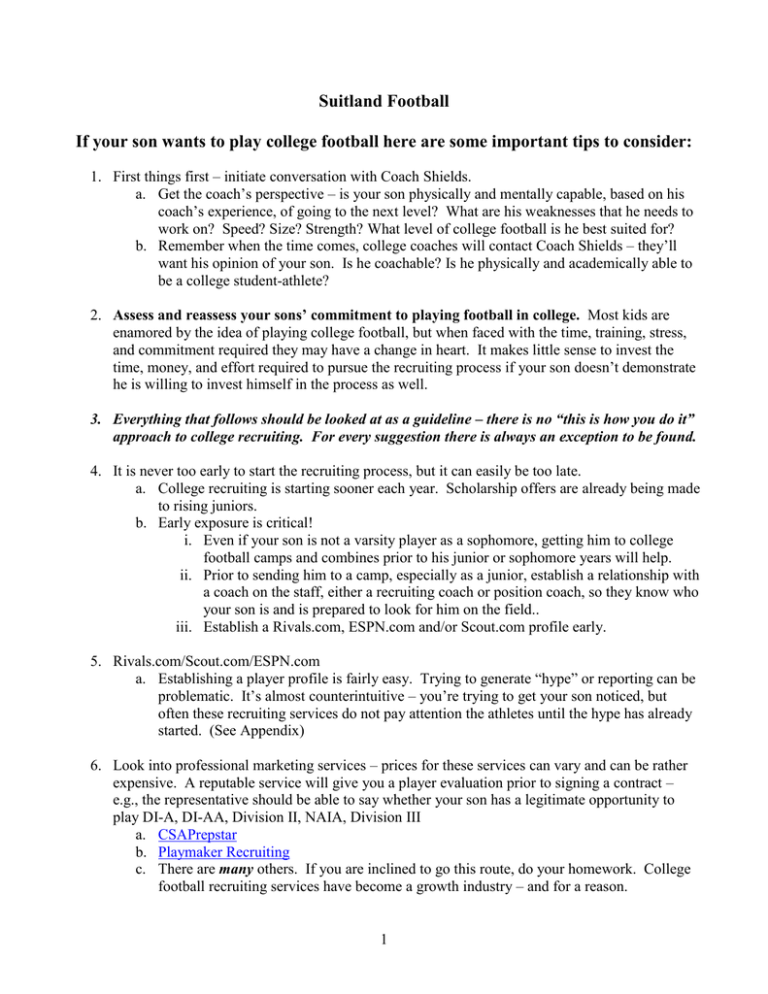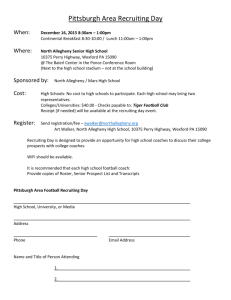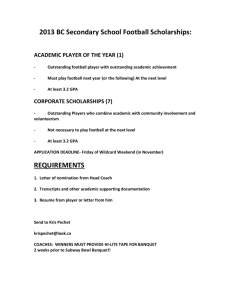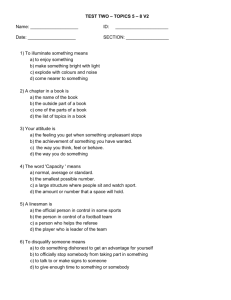Schools Offering Football
advertisement

Suitland Football If your son wants to play college football here are some important tips to consider: 1. First things first – initiate conversation with Coach Shields. a. Get the coach’s perspective – is your son physically and mentally capable, based on his coach’s experience, of going to the next level? What are his weaknesses that he needs to work on? Speed? Size? Strength? What level of college football is he best suited for? b. Remember when the time comes, college coaches will contact Coach Shields – they’ll want his opinion of your son. Is he coachable? Is he physically and academically able to be a college student-athlete? 2. Assess and reassess your sons’ commitment to playing football in college. Most kids are enamored by the idea of playing college football, but when faced with the time, training, stress, and commitment required they may have a change in heart. It makes little sense to invest the time, money, and effort required to pursue the recruiting process if your son doesn’t demonstrate he is willing to invest himself in the process as well. 3. Everything that follows should be looked at as a guideline – there is no “this is how you do it” approach to college recruiting. For every suggestion there is always an exception to be found. 4. It is never too early to start the recruiting process, but it can easily be too late. a. College recruiting is starting sooner each year. Scholarship offers are already being made to rising juniors. b. Early exposure is critical! i. Even if your son is not a varsity player as a sophomore, getting him to college football camps and combines prior to his junior or sophomore years will help. ii. Prior to sending him to a camp, especially as a junior, establish a relationship with a coach on the staff, either a recruiting coach or position coach, so they know who your son is and is prepared to look for him on the field.. iii. Establish a Rivals.com, ESPN.com and/or Scout.com profile early. 5. Rivals.com/Scout.com/ESPN.com a. Establishing a player profile is fairly easy. Trying to generate “hype” or reporting can be problematic. It’s almost counterintuitive – you’re trying to get your son noticed, but often these recruiting services do not pay attention the athletes until the hype has already started. (See Appendix) 6. Look into professional marketing services – prices for these services can vary and can be rather expensive. A reputable service will give you a player evaluation prior to signing a contract – e.g., the representative should be able to say whether your son has a legitimate opportunity to play DI-A, DI-AA, Division II, NAIA, Division III a. CSAPrepstar b. Playmaker Recruiting c. There are many others. If you are inclined to go this route, do your homework. College football recruiting services have become a growth industry – and for a reason. 1 2 7. Obtain game film and highlights as soon as possible from www.getitondvd.com. Highlights should run between 5-8 minutes. Put a cover on the DVD that conveys as much information about your son as possible but at a minimum includes GPA, SAT/ACT score, e-mail address, cell phone, home phone, and statistics. A picture is also a nice touch. a. Send initially to schools your son is interested in. For example, if your son wants to major in engineering, don’t bother sending to liberal arts colleges that do not offer an engineering degree. b. After the initial mailing, re-look your choices. If you’ve sent to 3 schools in a conference, consider expanding your list. c. In addition to the DVD, mail schools transcripts, ACT/SAT score results and a cover letter of introduction. Encourage your son to write the letter, with assistance as necessary, and have him sign. 8. Keep track of what you’re doing. Make a spreadsheet or database. Remember, you’re potentially dealing with tens of schools and you’ll want to remember what you’ve done with each. 3 9. Look for combines. Travel to them if necessary; however, the Washington/Baltimore region has several cycling through on an annual basis. Most important are the Nike/Sparq combine, the Scout/UnderArmor combine, the NATS combine, and the Bullseye Underclassman combine. a. Train, train, and train. Colleges look more for natural speed than size. If your son is 5’8”, 150lbs but can run a 40 in 4.3 he will get noticed. Conversely, if he’s 6’0”, 175, but runs a 4.8/4.9 he will not be drawing much interest. Most combines give the athlete an opportunity to “black out” poor scores in events. b. College coaches can not attend combines based on NCAA rules, but reports of performance are covered by Rivals and Scout.com and do get attention. c. For example, little-known Brandon Felder of Oxon Hill posted a great performance at the Nike/Sparq combine in Baltimore and within a week had an offer from Penn State. 10. If your son has completed his junior season and he has not been in contact with college coaches, he is already behind. The good news is, with effort, he can be back on track. a. It is absolutely critical to have your son attend college football camps the summer after his junior year. b. Pick colleges he would like to attend as well as schools that will have multiple colleges participating in their camp. For example, the University of Maryland camp usually includes coaches from Football Championship Subdivision (formerly called DI-AA) schools assist at their camp offering wider exposure. 11. Establish and build a relationship with college coaches through phone calls, mail and e-mail. a. Research college programs on the internet. 4 i. Search Google with the school name and football ii. For football contacts search within the Athletic Department tab. iii. Send e-mails to position coaches, offensive/defensive coordinators and Recruiting coordinators. Head coaches rarely have their personal e-mail available and queries are directed to their administrative assistants. 12. Just as important as anything in this handbook – college sports is about a student-athletics (note student first). There are several great athletes offered scholarships every year that are unable to meet the academic requirements to gain entry into a given school. If your son is truly interested in going on to college and playing football he has to be able to get the job done in the classroom as well as on the field. As a rule of thumb, a 3.0 GPA should be the standard. If he is below a 3.0, he needs to spend more time hitting the books than hanging out with his friends (this is part of the commitment needed mentioned in Paragraph #5). He also needs to do well on his SAT/ACT’s. Recommend he start taking the SAT his freshman year to understand the test and hone his test taking skills. Although the SAT has changed to a 3 part test (including the new essay portion) most schools still look at the SAT as a Math and Critical Reading only. These two sections have a total possible of 1600. The magic number for an athlete is 1,000. Many schools will take kids below 1,000, but very few will turn away an otherwise qualified athlete with 1,000 or higher. 13. Estimate and budget expenses. It’s great to think about getting 4-5 years of college paid for, but the reality is that it is not “free.” Be prepared to spend $3,000-10,000 dollars to prepare your son for the exposure required to garner that scholarship offer. In the long run, a $5,000 investment for a $125,000 education is a drop in the bucket – but you need to consider the costs. (See the checklist) 14. Things for consideration – By the Numbers Schools Offering Football NCAA Division I-A NCAA Division I-AA NCAA Division II 119 116 156 5 NCAA Division III NAIA NJCAA NCCAA Total Athletic Scholarship Opportunities Division I-A(per school) Division I-AA(per school) Division II(per school) NAIA Student-Athlete Participation NCAA Division I-A NCAA Division I-AA NCAA Division II NCAA Division III HS Student-Athletes 235 91 68 15 800 85 63 36 24 13,912 11,268 14,767 21,305 1,105,583 Per NCSA (another national recruiting service) http://www.ncsasports.org/student-athletes-families/football/recruiting-guidelines 15. Roughly 5.6% of high school athletes will go on to college and play college football. Just over half those athletes will receive an athletic scholarship to play football. Division II and NAIA schools can divide scholarships, for instance, an NAIA school has 24 scholarships to offer – the school can determine to offer 5 athletes full ride scholarships, while 10 scholarships will be cut in half and offered to 20 athletes, and the remaining 9 scholarships will be cut into quarters and divied up between 36 athletes. 16. Note that while a Division I-A school has 85 scholarships; this is for the entire team and represents the cap on scholarships for the entire team. For any given year, most schools will be able to offer approximately 21 scholarships. The same applies to all other divisions – divide the total number of scholarships by 4 for any given year. 17. Lastly, this guide is meant to help you position your son for opportunities for a scholarship. Talent alone will not take him far without exposure, opportunities, training, and dedication. However, the work doesn’t end once scholarship offers are made, but that is a separate issue for another time. If we can be of any assistance, please feel free to call us or send us an e-mail. (301) 641-3600 or eshields@comcast.net. 6 College Recruiting Checklist Have the conversation with your son early. o Ask him direct questions beyond “do you want to play football in college?” o Ask him what he intends to study in college. o What is most important to him in a school – academics or football? o Is the size of school important? o Is the location important? Does he want to be far away or as close as possible to home? o Does he want to play as soon as possible? Many schools Red Shirt incoming freshman to build on strength, conditioning, and size o Is he willing to wait his turn to play, even if it means waiting until he’s a junior or senior? This may be the difference between playing at the Division II level and Division I-A. o Carroll Field has the capacity to seat 4,000 spectators – is average crowd size at a college football game important? Many schools, especially D-II and D-III, won’t draw 1,000 people to games. o Is he willing to change positions to be able to play in college? o When looking at schools, make sure he’s asking himself “Can I be happy at this school if I weren’t playing football?” o There are many more questions he needs to ask himself and communicate to you – as you can see, it goes way beyond the initial question. Sit down and talk to Coach Shields – discuss your son’s interest and your son’s potential. Register with the NCAA clearinghouse o http://www.athleticscholarships.net/ncaa-clearinghouse.htm o Cost – $60 Quite possibly the single most important resource to have is the NCAA Guide for the College Bound Athlete – download or bookmark the site for your reference. o The NCAA.org website is a tremendous resource – while not organized particularly well, it has a ton of good information that you need to understand. For example, what is a core course and how many core courses must your son have to be eligible to play Division I football? When can college coaches contact your son, when can they not? Consult with a College Recruiter service o Cost – If you decide to enlist their services, it can run between $1,000-2,500. Any reputable service will meet with you free of charge to do an initial evaluation/consultation. Additionally, you should expect an honest evaluation as to which level your son can expect to play at. Obtain game/player stats. You can even keep the stats for your son during the season to ensure that you have them in the middle and end of season. 7 o Obtain game film. Contact GetitonDVD.com to get a copy of the season’s games as well as a professional highlight DVD of your son. If you are interested in this you have to order early as this company gets backed up doing the season. o Pre-Order Cost –$175 for all regular and post-season DVDs. o After Season or During Season Order Cost - $350 o After the 3rd Regular Season Game Cost- $150 all regular and post-season DVDs. o Individual games may be purchased for $15 each. Mostolleges will ask for a highlight reel 5-8 minutes in length plus one full game Burn both on a DVD and make multiple copies. Mail to schools, along with transcripts, ACT/SAT scores and a cover letter, preferably written by your son, introducing himself to the college coach. o Remember, these schools are receiving hundreds if not thousands of DVDs from kids all across the country. Make your DVD stand-out as best as possible. o Cost – envelopes, DVD’s, cases, postage – approximately $5 per school mailing Post highlights on YouTube.com o E-mail the coaches at schools you mailed DVD’s to. Include the YouTube link of your sons’ highlights in the e-mail and let them know you’ve mailed DVDs to them so they will know to expect it. Look for Combines to attend o PGCFCA, MD State Combine and Playmaker Recruiting Combine o Cost – varies. $10-60 per combine, some are free of charge. o If a combine is “invite only” contact the coordinator for an invitation. Spring camps o Some schools will invite your son to attend “Junior Day” or Spring Practices at the school. Be selective and understand that the school is inviting hundreds of kids to attend these recruiting events. Target the schools he is interested in – call the coaching staffs and make sure they know he is coming so he is on their radar when he arrives and is just not a face in the large crowd. o Cost – varies depending on geography and travel. Can be up to $1,000 for airline tickets, hotel, and rental car. 8 Football camps o Most football camps begin in early June. Some are scheduled before school is out for the summer. Camps are an extremely important part of the recruiting process. Since college coaches are not allowed to attend combines, this may be their only and/or best opportunity to see your son. o Research camp dates – almost every football program has a link from their homepage for the camp. o Important things to remember here – if your son is a junior, do not have him attend the full camp. Coaches only need to see him for one day. Contact the coaches directly to see which day is best to show up at. Some schools will run one day camps; others can be as many as four days. Camps are a cash-cow for the coaching staffs – if they say your son should attend the entire camp; they are more interested in taking your money than evaluating your son. Make sure the coach is aware that your son will be attending camp on the specific date so they can give him the best look possible. o When you are planning your camp itinerary, be extremely cautious about scheduling back-to-back camps. Remember, these camps are physically demanding and conducted in the heat of summer. When camping back-to-back you run the very real risk that your son will not be able to perform at his full potential on the 2nd day. o Prepare to spend time on the road – this means weekends and time away from work and little vacation time for the family. Are you willing to do it? Is your son willing to give up his summer to go to camps? Take another player with you – especially someone who is potentially capable of playing at the next level. o Cost – varies greatly – depends on geography and mode of travel. One day camps are normally pro-rated but can cost between $20-85 for the camp alone. Travel costs, gasoline, airline, hotels, food, etc. can range between $500 and $2,500 depending on the number of camps you plan to attend and their location. Stay in touch with your recruiting coaches afterward o Be prepared to e-mail and/or call coaches on a regular basis. o Provide them updates as to how your son is doing – did he just attend a combine and score well in events? o Did he receive an offer from a different school? o Encourage your son to call the coach as well on a regular basis. While coaches want to talk to parents, in the end, they are more interested in having the conversation with your son. 9 APPENDIX 10 RIVALS.COM Player Profile Note the increase in reporting on Alec following his scholarship offers. In addition, Rivals had Alec’s video highlights dating back to December 2007. They did not get added to his profile until August 2008 – after receiving his offers. Rivals.com has “recruiting analysts” throughout the country that write articles for different schools. In Alec’s case, since he traveled all over the country, different writer’s covered him for different schools. You may also note that in his profile he has 2 stars. He didn’t receive a star rating until after he committed to Syracuse. 11 ESPN.Com Player Profile Mail highlight DVD to: ESPN Two Elm Square Andover, MA 01810 Player evaluation is based on Junior year highlight video If you have questions contact David Geaslen at: David.Geaslen@espn.com ESPN is a relative new comer to the college recruiting business, behind Rivals and Scout; however, they were far and away the most responsive. Within 2-3 weeks of sending his highlights to ESPN they established his player profile and a very detailed evaluation of him as a player. 12 SCOUT.COM Player Profile Scout is very much like Rivals in that they have “beat writers” or “recruiting analysts” covering different regions or schools. Just like Rivals, Scout did not assign a position ranking to Alec until after he committed Syracuse, despite the fact that his player profile was established 10 or so months before hand. Unlike Rivals, Scout never posted his highlight film, despite having it months in advance. _________________________________________________________________________________ With all these services, while it can be frustrating to watch the slow progress they make in “helping” your son – keep in mind that coaches are not necessarily buying into the hype. Rivals and Scout assign star ratings based on the fact that certain schools have made scholarship offers. For example, if USC or LSU have offered a rising junior after attending their camp, both of these services will probably give that kid a 3 star rating without even looking at his film. Take it with a grain of salt, there are many kids out there that have received scholarship offers that never had a player profile established. There is some value involved beyond simply ego. Many of the recruiting analysts, notably the gentleman that covers Vanderbilt, are very plugged in to the coaching staff and have considerable credibility. While nice to have – it’s not a deal breaker. Writers will want to talk to your son and not you, polishing interview skills takes time and should be practiced. 13





